Direct to Home: Business Plan for Online Food Delivery Start-up
VerifiedAdded on 2022/12/28
|14
|3957
|67
Report
AI Summary
This business plan outlines the strategy for Direct to Home, an online food delivery start-up. It begins with an introduction to the concept and its potential, followed by a detailed analysis of the business's vision, mission, and external environment. The report includes a micro and macro analysis, focusing on factors such as employees, finances, political, economic, social, technological, legal, and environmental influences. It also provides a competitor analysis using Porter's Five Forces model, assessing the threats of new entrants, buyer power, supplier power, substitution, and competitive rivalry. The plan further delves into segmentation analysis, targeting geographical, demographic, psychographic, price, and time-based market segments. It then outlines a comprehensive marketing strategy using the 7Ps of the marketing mix, including product, price, promotion, place, people, process, and physical evidence. Financial resources and risk analysis are also discussed, offering a complete overview of the start-up's operational and strategic approach, concluding with references to supporting literature.

Business plan
Paraphrase This Document
Need a fresh take? Get an instant paraphrase of this document with our AI Paraphraser
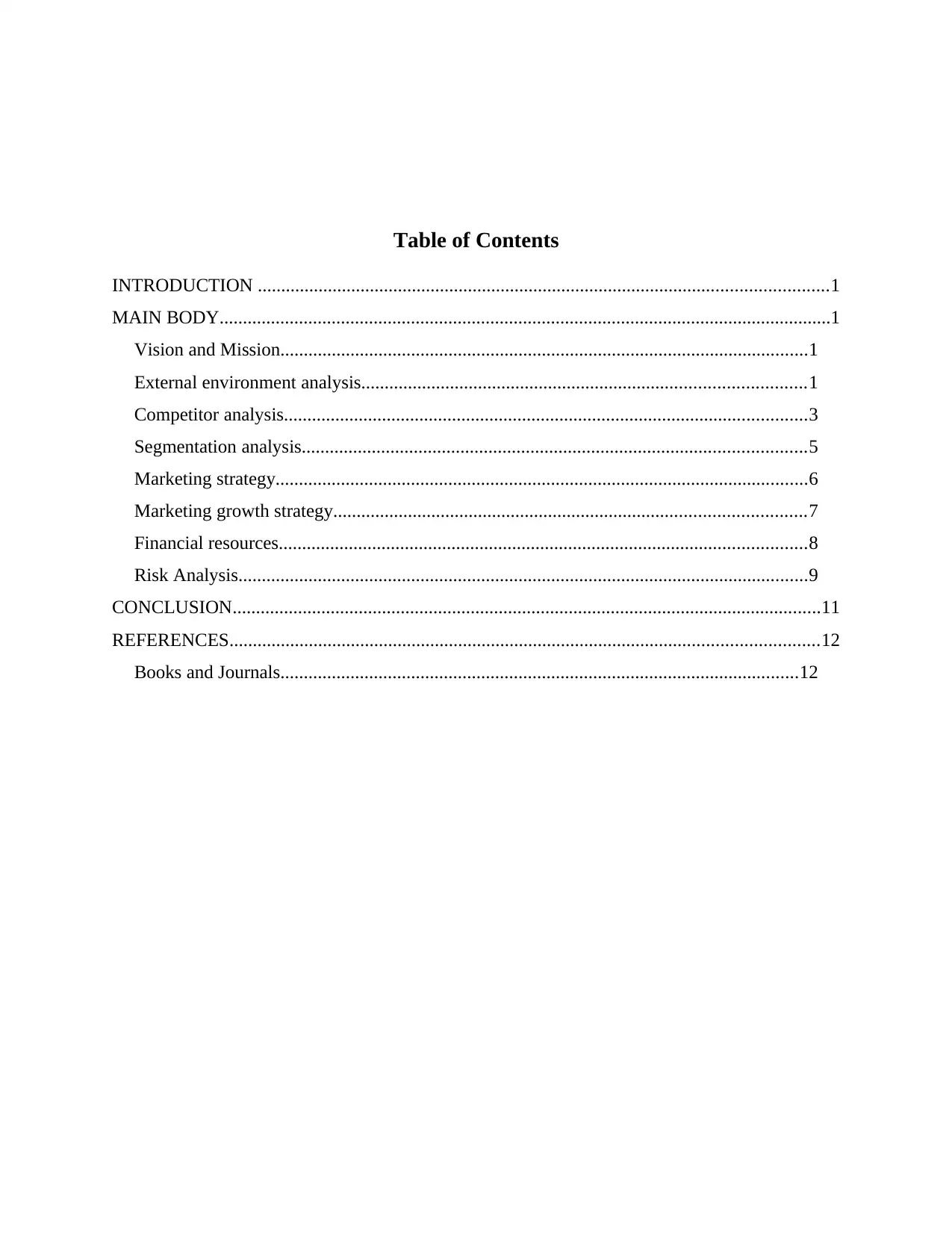
Table of Contents
INTRODUCTION ..........................................................................................................................1
MAIN BODY...................................................................................................................................1
Vision and Mission.................................................................................................................1
External environment analysis...............................................................................................1
Competitor analysis................................................................................................................3
Segmentation analysis............................................................................................................5
Marketing strategy..................................................................................................................6
Marketing growth strategy.....................................................................................................7
Financial resources.................................................................................................................8
Risk Analysis..........................................................................................................................9
CONCLUSION..............................................................................................................................11
REFERENCES..............................................................................................................................12
Books and Journals...............................................................................................................12
INTRODUCTION ..........................................................................................................................1
MAIN BODY...................................................................................................................................1
Vision and Mission.................................................................................................................1
External environment analysis...............................................................................................1
Competitor analysis................................................................................................................3
Segmentation analysis............................................................................................................5
Marketing strategy..................................................................................................................6
Marketing growth strategy.....................................................................................................7
Financial resources.................................................................................................................8
Risk Analysis..........................................................................................................................9
CONCLUSION..............................................................................................................................11
REFERENCES..............................................................................................................................12
Books and Journals...............................................................................................................12

⊘ This is a preview!⊘
Do you want full access?
Subscribe today to unlock all pages.

Trusted by 1+ million students worldwide
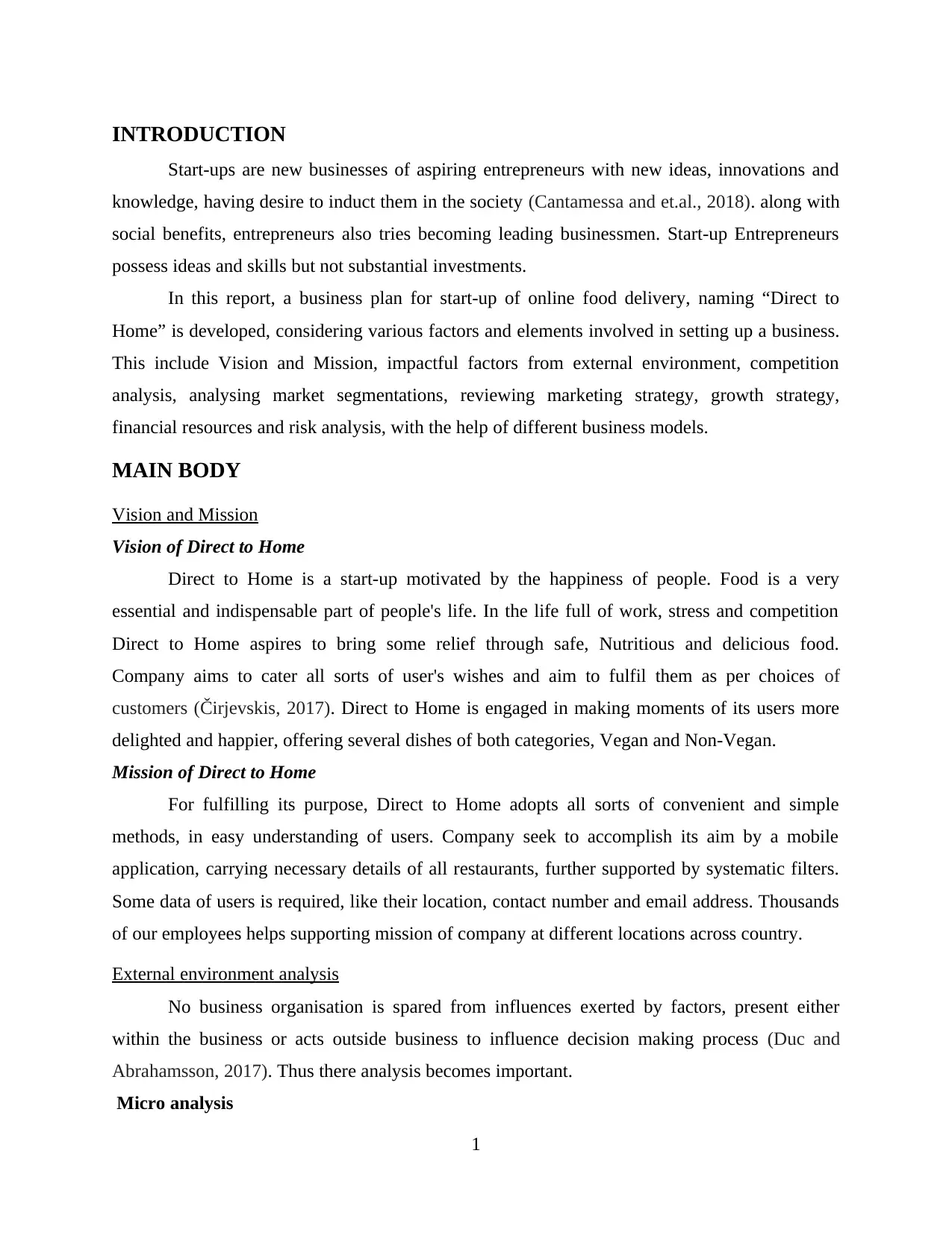
INTRODUCTION
Start-ups are new businesses of aspiring entrepreneurs with new ideas, innovations and
knowledge, having desire to induct them in the society (Cantamessa and et.al., 2018). along with
social benefits, entrepreneurs also tries becoming leading businessmen. Start-up Entrepreneurs
possess ideas and skills but not substantial investments.
In this report, a business plan for start-up of online food delivery, naming “Direct to
Home” is developed, considering various factors and elements involved in setting up a business.
This include Vision and Mission, impactful factors from external environment, competition
analysis, analysing market segmentations, reviewing marketing strategy, growth strategy,
financial resources and risk analysis, with the help of different business models.
MAIN BODY
Vision and Mission
Vision of Direct to Home
Direct to Home is a start-up motivated by the happiness of people. Food is a very
essential and indispensable part of people's life. In the life full of work, stress and competition
Direct to Home aspires to bring some relief through safe, Nutritious and delicious food.
Company aims to cater all sorts of user's wishes and aim to fulfil them as per choices of
customers (Čirjevskis, 2017). Direct to Home is engaged in making moments of its users more
delighted and happier, offering several dishes of both categories, Vegan and Non-Vegan.
Mission of Direct to Home
For fulfilling its purpose, Direct to Home adopts all sorts of convenient and simple
methods, in easy understanding of users. Company seek to accomplish its aim by a mobile
application, carrying necessary details of all restaurants, further supported by systematic filters.
Some data of users is required, like their location, contact number and email address. Thousands
of our employees helps supporting mission of company at different locations across country.
External environment analysis
No business organisation is spared from influences exerted by factors, present either
within the business or acts outside business to influence decision making process (Duc and
Abrahamsson, 2017). Thus there analysis becomes important.
Micro analysis
1
Start-ups are new businesses of aspiring entrepreneurs with new ideas, innovations and
knowledge, having desire to induct them in the society (Cantamessa and et.al., 2018). along with
social benefits, entrepreneurs also tries becoming leading businessmen. Start-up Entrepreneurs
possess ideas and skills but not substantial investments.
In this report, a business plan for start-up of online food delivery, naming “Direct to
Home” is developed, considering various factors and elements involved in setting up a business.
This include Vision and Mission, impactful factors from external environment, competition
analysis, analysing market segmentations, reviewing marketing strategy, growth strategy,
financial resources and risk analysis, with the help of different business models.
MAIN BODY
Vision and Mission
Vision of Direct to Home
Direct to Home is a start-up motivated by the happiness of people. Food is a very
essential and indispensable part of people's life. In the life full of work, stress and competition
Direct to Home aspires to bring some relief through safe, Nutritious and delicious food.
Company aims to cater all sorts of user's wishes and aim to fulfil them as per choices of
customers (Čirjevskis, 2017). Direct to Home is engaged in making moments of its users more
delighted and happier, offering several dishes of both categories, Vegan and Non-Vegan.
Mission of Direct to Home
For fulfilling its purpose, Direct to Home adopts all sorts of convenient and simple
methods, in easy understanding of users. Company seek to accomplish its aim by a mobile
application, carrying necessary details of all restaurants, further supported by systematic filters.
Some data of users is required, like their location, contact number and email address. Thousands
of our employees helps supporting mission of company at different locations across country.
External environment analysis
No business organisation is spared from influences exerted by factors, present either
within the business or acts outside business to influence decision making process (Duc and
Abrahamsson, 2017). Thus there analysis becomes important.
Micro analysis
1
Paraphrase This Document
Need a fresh take? Get an instant paraphrase of this document with our AI Paraphraser
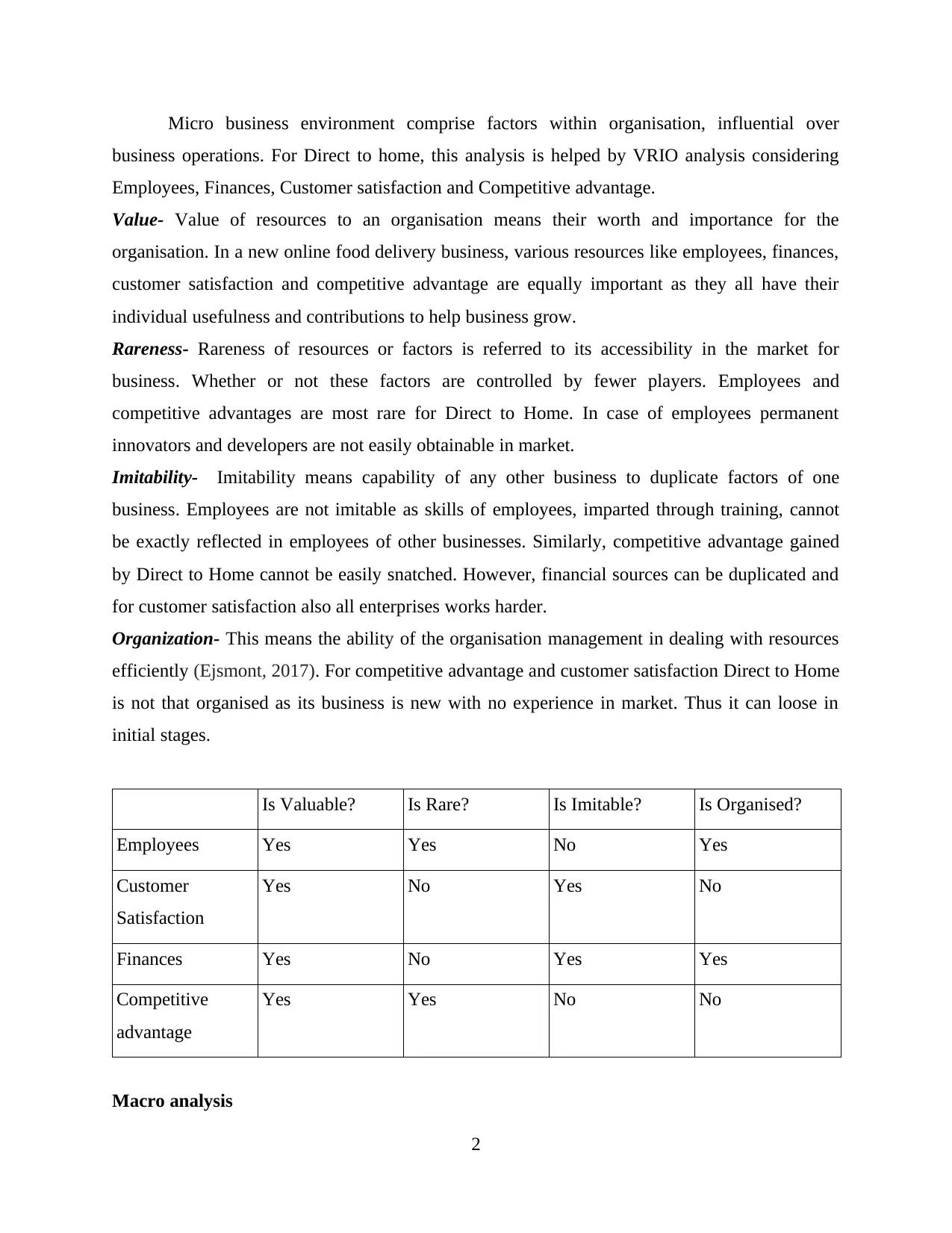
Micro business environment comprise factors within organisation, influential over
business operations. For Direct to home, this analysis is helped by VRIO analysis considering
Employees, Finances, Customer satisfaction and Competitive advantage.
Value- Value of resources to an organisation means their worth and importance for the
organisation. In a new online food delivery business, various resources like employees, finances,
customer satisfaction and competitive advantage are equally important as they all have their
individual usefulness and contributions to help business grow.
Rareness- Rareness of resources or factors is referred to its accessibility in the market for
business. Whether or not these factors are controlled by fewer players. Employees and
competitive advantages are most rare for Direct to Home. In case of employees permanent
innovators and developers are not easily obtainable in market.
Imitability- Imitability means capability of any other business to duplicate factors of one
business. Employees are not imitable as skills of employees, imparted through training, cannot
be exactly reflected in employees of other businesses. Similarly, competitive advantage gained
by Direct to Home cannot be easily snatched. However, financial sources can be duplicated and
for customer satisfaction also all enterprises works harder.
Organization- This means the ability of the organisation management in dealing with resources
efficiently (Ejsmont, 2017). For competitive advantage and customer satisfaction Direct to Home
is not that organised as its business is new with no experience in market. Thus it can loose in
initial stages.
Is Valuable? Is Rare? Is Imitable? Is Organised?
Employees Yes Yes No Yes
Customer
Satisfaction
Yes No Yes No
Finances Yes No Yes Yes
Competitive
advantage
Yes Yes No No
Macro analysis
2
business operations. For Direct to home, this analysis is helped by VRIO analysis considering
Employees, Finances, Customer satisfaction and Competitive advantage.
Value- Value of resources to an organisation means their worth and importance for the
organisation. In a new online food delivery business, various resources like employees, finances,
customer satisfaction and competitive advantage are equally important as they all have their
individual usefulness and contributions to help business grow.
Rareness- Rareness of resources or factors is referred to its accessibility in the market for
business. Whether or not these factors are controlled by fewer players. Employees and
competitive advantages are most rare for Direct to Home. In case of employees permanent
innovators and developers are not easily obtainable in market.
Imitability- Imitability means capability of any other business to duplicate factors of one
business. Employees are not imitable as skills of employees, imparted through training, cannot
be exactly reflected in employees of other businesses. Similarly, competitive advantage gained
by Direct to Home cannot be easily snatched. However, financial sources can be duplicated and
for customer satisfaction also all enterprises works harder.
Organization- This means the ability of the organisation management in dealing with resources
efficiently (Ejsmont, 2017). For competitive advantage and customer satisfaction Direct to Home
is not that organised as its business is new with no experience in market. Thus it can loose in
initial stages.
Is Valuable? Is Rare? Is Imitable? Is Organised?
Employees Yes Yes No Yes
Customer
Satisfaction
Yes No Yes No
Finances Yes No Yes Yes
Competitive
advantage
Yes Yes No No
Macro analysis
2
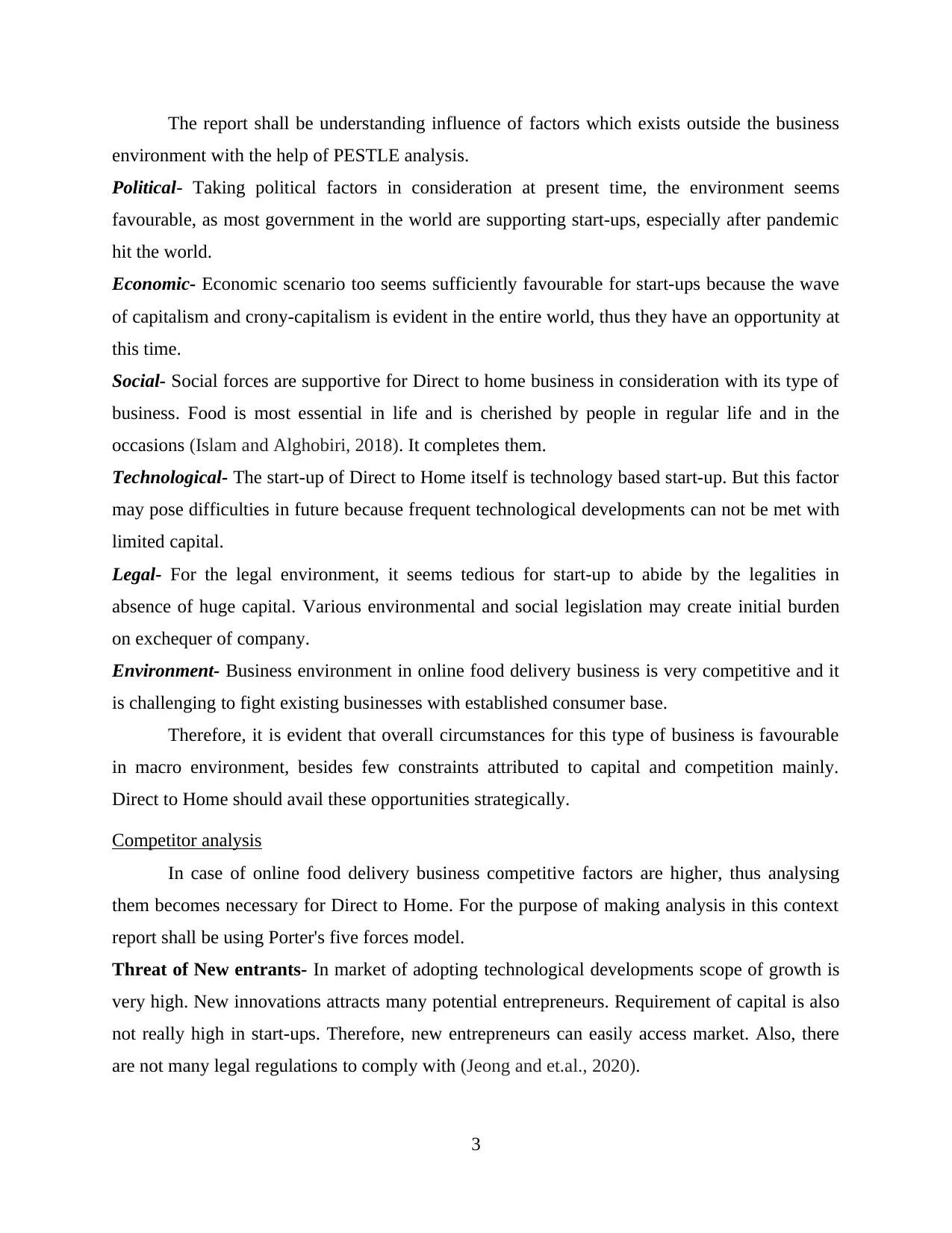
The report shall be understanding influence of factors which exists outside the business
environment with the help of PESTLE analysis.
Political- Taking political factors in consideration at present time, the environment seems
favourable, as most government in the world are supporting start-ups, especially after pandemic
hit the world.
Economic- Economic scenario too seems sufficiently favourable for start-ups because the wave
of capitalism and crony-capitalism is evident in the entire world, thus they have an opportunity at
this time.
Social- Social forces are supportive for Direct to home business in consideration with its type of
business. Food is most essential in life and is cherished by people in regular life and in the
occasions (Islam and Alghobiri, 2018). It completes them.
Technological- The start-up of Direct to Home itself is technology based start-up. But this factor
may pose difficulties in future because frequent technological developments can not be met with
limited capital.
Legal- For the legal environment, it seems tedious for start-up to abide by the legalities in
absence of huge capital. Various environmental and social legislation may create initial burden
on exchequer of company.
Environment- Business environment in online food delivery business is very competitive and it
is challenging to fight existing businesses with established consumer base.
Therefore, it is evident that overall circumstances for this type of business is favourable
in macro environment, besides few constraints attributed to capital and competition mainly.
Direct to Home should avail these opportunities strategically.
Competitor analysis
In case of online food delivery business competitive factors are higher, thus analysing
them becomes necessary for Direct to Home. For the purpose of making analysis in this context
report shall be using Porter's five forces model.
Threat of New entrants- In market of adopting technological developments scope of growth is
very high. New innovations attracts many potential entrepreneurs. Requirement of capital is also
not really high in start-ups. Therefore, new entrepreneurs can easily access market. Also, there
are not many legal regulations to comply with (Jeong and et.al., 2020).
3
environment with the help of PESTLE analysis.
Political- Taking political factors in consideration at present time, the environment seems
favourable, as most government in the world are supporting start-ups, especially after pandemic
hit the world.
Economic- Economic scenario too seems sufficiently favourable for start-ups because the wave
of capitalism and crony-capitalism is evident in the entire world, thus they have an opportunity at
this time.
Social- Social forces are supportive for Direct to home business in consideration with its type of
business. Food is most essential in life and is cherished by people in regular life and in the
occasions (Islam and Alghobiri, 2018). It completes them.
Technological- The start-up of Direct to Home itself is technology based start-up. But this factor
may pose difficulties in future because frequent technological developments can not be met with
limited capital.
Legal- For the legal environment, it seems tedious for start-up to abide by the legalities in
absence of huge capital. Various environmental and social legislation may create initial burden
on exchequer of company.
Environment- Business environment in online food delivery business is very competitive and it
is challenging to fight existing businesses with established consumer base.
Therefore, it is evident that overall circumstances for this type of business is favourable
in macro environment, besides few constraints attributed to capital and competition mainly.
Direct to Home should avail these opportunities strategically.
Competitor analysis
In case of online food delivery business competitive factors are higher, thus analysing
them becomes necessary for Direct to Home. For the purpose of making analysis in this context
report shall be using Porter's five forces model.
Threat of New entrants- In market of adopting technological developments scope of growth is
very high. New innovations attracts many potential entrepreneurs. Requirement of capital is also
not really high in start-ups. Therefore, new entrepreneurs can easily access market. Also, there
are not many legal regulations to comply with (Jeong and et.al., 2020).
3
⊘ This is a preview!⊘
Do you want full access?
Subscribe today to unlock all pages.

Trusted by 1+ million students worldwide
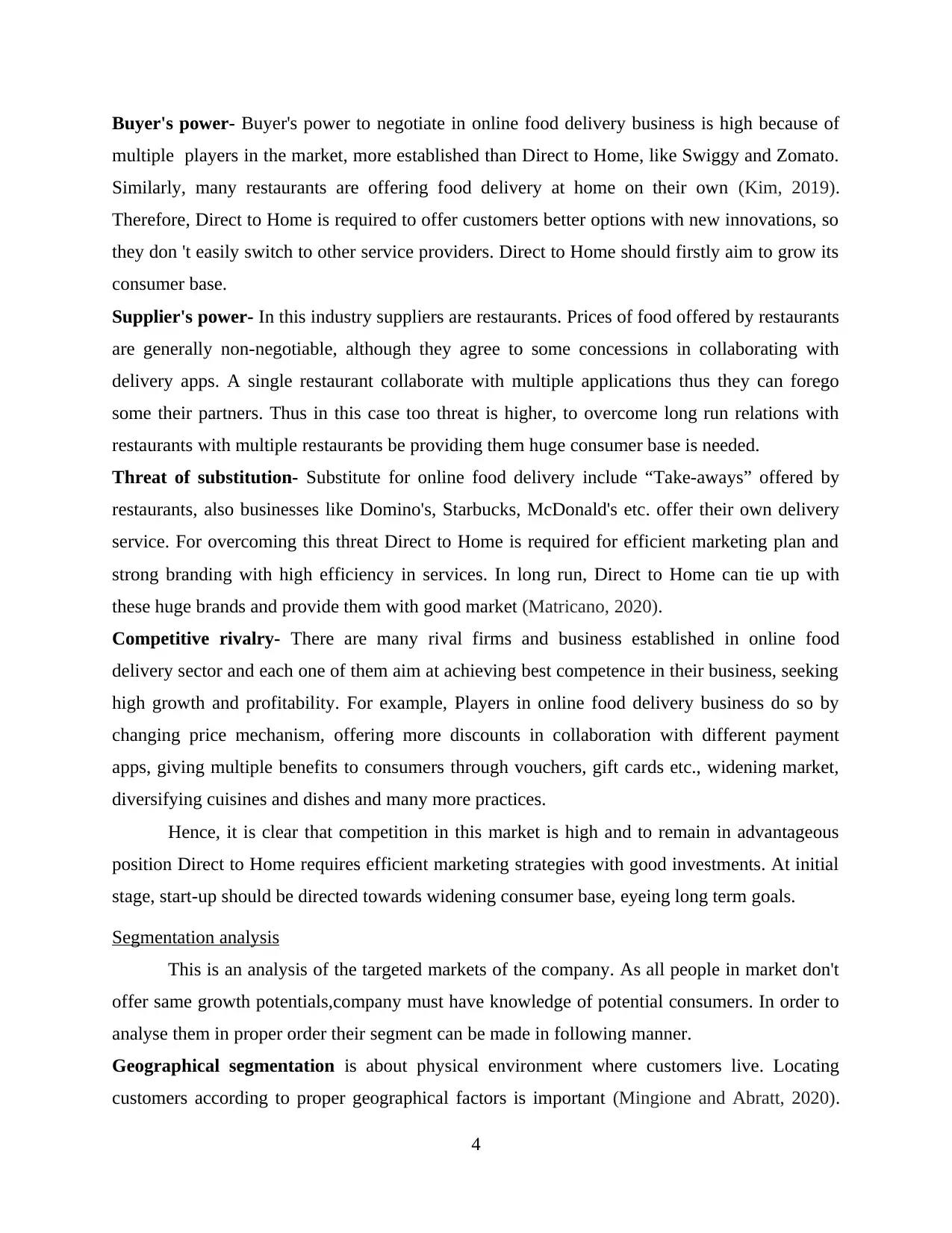
Buyer's power- Buyer's power to negotiate in online food delivery business is high because of
multiple players in the market, more established than Direct to Home, like Swiggy and Zomato.
Similarly, many restaurants are offering food delivery at home on their own (Kim, 2019).
Therefore, Direct to Home is required to offer customers better options with new innovations, so
they don 't easily switch to other service providers. Direct to Home should firstly aim to grow its
consumer base.
Supplier's power- In this industry suppliers are restaurants. Prices of food offered by restaurants
are generally non-negotiable, although they agree to some concessions in collaborating with
delivery apps. A single restaurant collaborate with multiple applications thus they can forego
some their partners. Thus in this case too threat is higher, to overcome long run relations with
restaurants with multiple restaurants be providing them huge consumer base is needed.
Threat of substitution- Substitute for online food delivery include “Take-aways” offered by
restaurants, also businesses like Domino's, Starbucks, McDonald's etc. offer their own delivery
service. For overcoming this threat Direct to Home is required for efficient marketing plan and
strong branding with high efficiency in services. In long run, Direct to Home can tie up with
these huge brands and provide them with good market (Matricano, 2020).
Competitive rivalry- There are many rival firms and business established in online food
delivery sector and each one of them aim at achieving best competence in their business, seeking
high growth and profitability. For example, Players in online food delivery business do so by
changing price mechanism, offering more discounts in collaboration with different payment
apps, giving multiple benefits to consumers through vouchers, gift cards etc., widening market,
diversifying cuisines and dishes and many more practices.
Hence, it is clear that competition in this market is high and to remain in advantageous
position Direct to Home requires efficient marketing strategies with good investments. At initial
stage, start-up should be directed towards widening consumer base, eyeing long term goals.
Segmentation analysis
This is an analysis of the targeted markets of the company. As all people in market don't
offer same growth potentials,company must have knowledge of potential consumers. In order to
analyse them in proper order their segment can be made in following manner.
Geographical segmentation is about physical environment where customers live. Locating
customers according to proper geographical factors is important (Mingione and Abratt, 2020).
4
multiple players in the market, more established than Direct to Home, like Swiggy and Zomato.
Similarly, many restaurants are offering food delivery at home on their own (Kim, 2019).
Therefore, Direct to Home is required to offer customers better options with new innovations, so
they don 't easily switch to other service providers. Direct to Home should firstly aim to grow its
consumer base.
Supplier's power- In this industry suppliers are restaurants. Prices of food offered by restaurants
are generally non-negotiable, although they agree to some concessions in collaborating with
delivery apps. A single restaurant collaborate with multiple applications thus they can forego
some their partners. Thus in this case too threat is higher, to overcome long run relations with
restaurants with multiple restaurants be providing them huge consumer base is needed.
Threat of substitution- Substitute for online food delivery include “Take-aways” offered by
restaurants, also businesses like Domino's, Starbucks, McDonald's etc. offer their own delivery
service. For overcoming this threat Direct to Home is required for efficient marketing plan and
strong branding with high efficiency in services. In long run, Direct to Home can tie up with
these huge brands and provide them with good market (Matricano, 2020).
Competitive rivalry- There are many rival firms and business established in online food
delivery sector and each one of them aim at achieving best competence in their business, seeking
high growth and profitability. For example, Players in online food delivery business do so by
changing price mechanism, offering more discounts in collaboration with different payment
apps, giving multiple benefits to consumers through vouchers, gift cards etc., widening market,
diversifying cuisines and dishes and many more practices.
Hence, it is clear that competition in this market is high and to remain in advantageous
position Direct to Home requires efficient marketing strategies with good investments. At initial
stage, start-up should be directed towards widening consumer base, eyeing long term goals.
Segmentation analysis
This is an analysis of the targeted markets of the company. As all people in market don't
offer same growth potentials,company must have knowledge of potential consumers. In order to
analyse them in proper order their segment can be made in following manner.
Geographical segmentation is about physical environment where customers live. Locating
customers according to proper geographical factors is important (Mingione and Abratt, 2020).
4
Paraphrase This Document
Need a fresh take? Get an instant paraphrase of this document with our AI Paraphraser
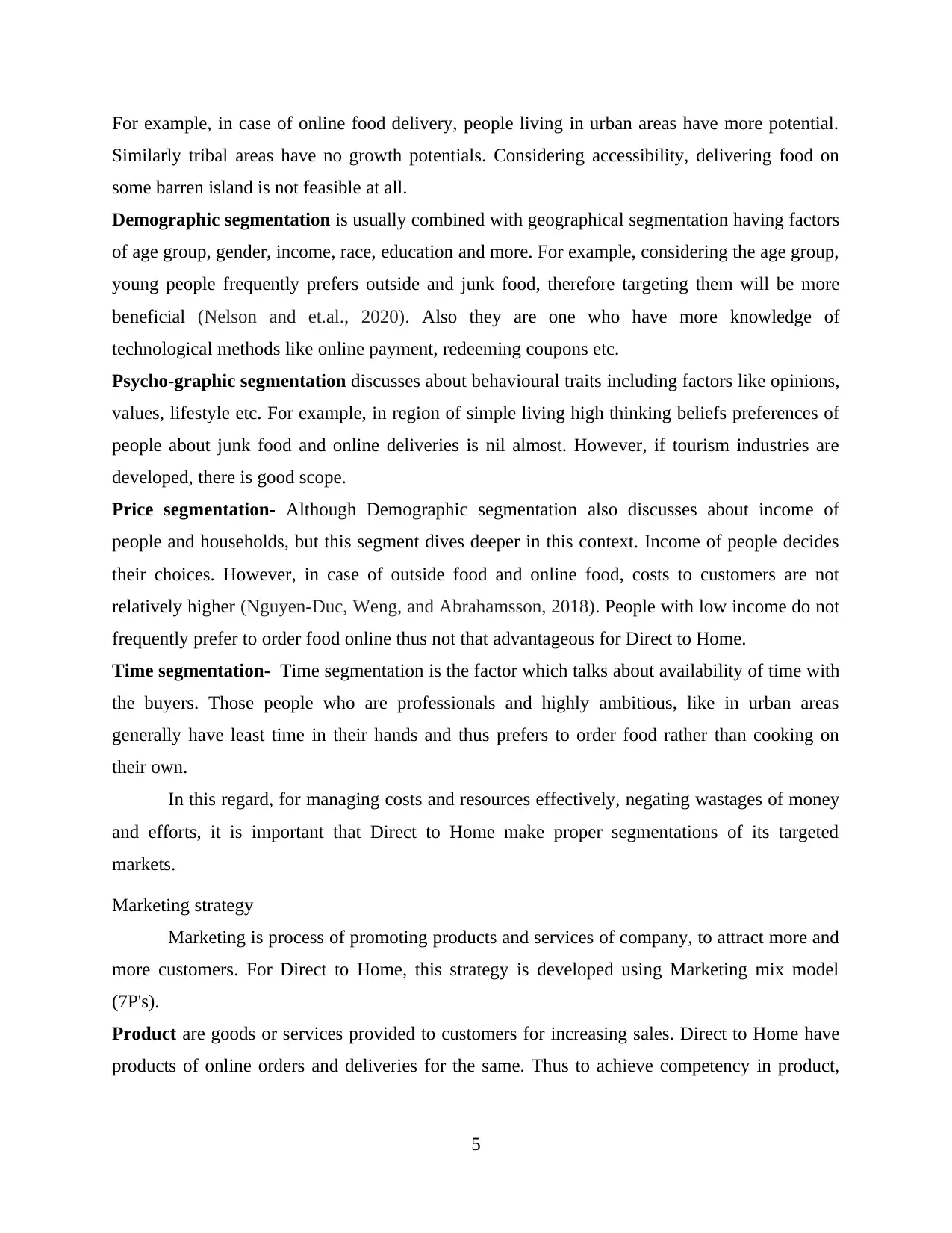
For example, in case of online food delivery, people living in urban areas have more potential.
Similarly tribal areas have no growth potentials. Considering accessibility, delivering food on
some barren island is not feasible at all.
Demographic segmentation is usually combined with geographical segmentation having factors
of age group, gender, income, race, education and more. For example, considering the age group,
young people frequently prefers outside and junk food, therefore targeting them will be more
beneficial (Nelson and et.al., 2020). Also they are one who have more knowledge of
technological methods like online payment, redeeming coupons etc.
Psycho-graphic segmentation discusses about behavioural traits including factors like opinions,
values, lifestyle etc. For example, in region of simple living high thinking beliefs preferences of
people about junk food and online deliveries is nil almost. However, if tourism industries are
developed, there is good scope.
Price segmentation- Although Demographic segmentation also discusses about income of
people and households, but this segment dives deeper in this context. Income of people decides
their choices. However, in case of outside food and online food, costs to customers are not
relatively higher (Nguyen-Duc, Weng, and Abrahamsson, 2018). People with low income do not
frequently prefer to order food online thus not that advantageous for Direct to Home.
Time segmentation- Time segmentation is the factor which talks about availability of time with
the buyers. Those people who are professionals and highly ambitious, like in urban areas
generally have least time in their hands and thus prefers to order food rather than cooking on
their own.
In this regard, for managing costs and resources effectively, negating wastages of money
and efforts, it is important that Direct to Home make proper segmentations of its targeted
markets.
Marketing strategy
Marketing is process of promoting products and services of company, to attract more and
more customers. For Direct to Home, this strategy is developed using Marketing mix model
(7P's).
Product are goods or services provided to customers for increasing sales. Direct to Home have
products of online orders and deliveries for the same. Thus to achieve competency in product,
5
Similarly tribal areas have no growth potentials. Considering accessibility, delivering food on
some barren island is not feasible at all.
Demographic segmentation is usually combined with geographical segmentation having factors
of age group, gender, income, race, education and more. For example, considering the age group,
young people frequently prefers outside and junk food, therefore targeting them will be more
beneficial (Nelson and et.al., 2020). Also they are one who have more knowledge of
technological methods like online payment, redeeming coupons etc.
Psycho-graphic segmentation discusses about behavioural traits including factors like opinions,
values, lifestyle etc. For example, in region of simple living high thinking beliefs preferences of
people about junk food and online deliveries is nil almost. However, if tourism industries are
developed, there is good scope.
Price segmentation- Although Demographic segmentation also discusses about income of
people and households, but this segment dives deeper in this context. Income of people decides
their choices. However, in case of outside food and online food, costs to customers are not
relatively higher (Nguyen-Duc, Weng, and Abrahamsson, 2018). People with low income do not
frequently prefer to order food online thus not that advantageous for Direct to Home.
Time segmentation- Time segmentation is the factor which talks about availability of time with
the buyers. Those people who are professionals and highly ambitious, like in urban areas
generally have least time in their hands and thus prefers to order food rather than cooking on
their own.
In this regard, for managing costs and resources effectively, negating wastages of money
and efforts, it is important that Direct to Home make proper segmentations of its targeted
markets.
Marketing strategy
Marketing is process of promoting products and services of company, to attract more and
more customers. For Direct to Home, this strategy is developed using Marketing mix model
(7P's).
Product are goods or services provided to customers for increasing sales. Direct to Home have
products of online orders and deliveries for the same. Thus to achieve competency in product,
5
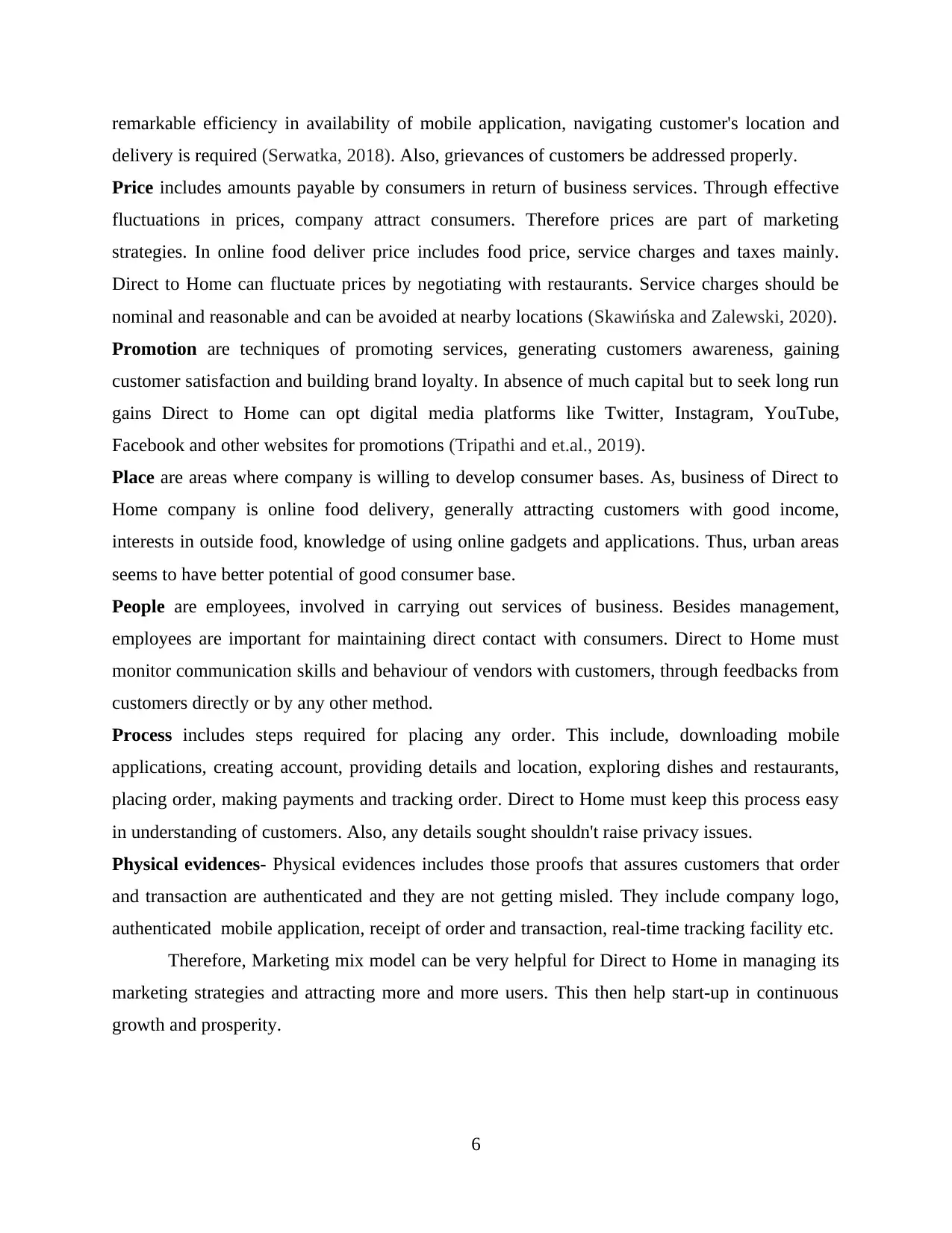
remarkable efficiency in availability of mobile application, navigating customer's location and
delivery is required (Serwatka, 2018). Also, grievances of customers be addressed properly.
Price includes amounts payable by consumers in return of business services. Through effective
fluctuations in prices, company attract consumers. Therefore prices are part of marketing
strategies. In online food deliver price includes food price, service charges and taxes mainly.
Direct to Home can fluctuate prices by negotiating with restaurants. Service charges should be
nominal and reasonable and can be avoided at nearby locations (Skawińska and Zalewski, 2020).
Promotion are techniques of promoting services, generating customers awareness, gaining
customer satisfaction and building brand loyalty. In absence of much capital but to seek long run
gains Direct to Home can opt digital media platforms like Twitter, Instagram, YouTube,
Facebook and other websites for promotions (Tripathi and et.al., 2019).
Place are areas where company is willing to develop consumer bases. As, business of Direct to
Home company is online food delivery, generally attracting customers with good income,
interests in outside food, knowledge of using online gadgets and applications. Thus, urban areas
seems to have better potential of good consumer base.
People are employees, involved in carrying out services of business. Besides management,
employees are important for maintaining direct contact with consumers. Direct to Home must
monitor communication skills and behaviour of vendors with customers, through feedbacks from
customers directly or by any other method.
Process includes steps required for placing any order. This include, downloading mobile
applications, creating account, providing details and location, exploring dishes and restaurants,
placing order, making payments and tracking order. Direct to Home must keep this process easy
in understanding of customers. Also, any details sought shouldn't raise privacy issues.
Physical evidences- Physical evidences includes those proofs that assures customers that order
and transaction are authenticated and they are not getting misled. They include company logo,
authenticated mobile application, receipt of order and transaction, real-time tracking facility etc.
Therefore, Marketing mix model can be very helpful for Direct to Home in managing its
marketing strategies and attracting more and more users. This then help start-up in continuous
growth and prosperity.
6
delivery is required (Serwatka, 2018). Also, grievances of customers be addressed properly.
Price includes amounts payable by consumers in return of business services. Through effective
fluctuations in prices, company attract consumers. Therefore prices are part of marketing
strategies. In online food deliver price includes food price, service charges and taxes mainly.
Direct to Home can fluctuate prices by negotiating with restaurants. Service charges should be
nominal and reasonable and can be avoided at nearby locations (Skawińska and Zalewski, 2020).
Promotion are techniques of promoting services, generating customers awareness, gaining
customer satisfaction and building brand loyalty. In absence of much capital but to seek long run
gains Direct to Home can opt digital media platforms like Twitter, Instagram, YouTube,
Facebook and other websites for promotions (Tripathi and et.al., 2019).
Place are areas where company is willing to develop consumer bases. As, business of Direct to
Home company is online food delivery, generally attracting customers with good income,
interests in outside food, knowledge of using online gadgets and applications. Thus, urban areas
seems to have better potential of good consumer base.
People are employees, involved in carrying out services of business. Besides management,
employees are important for maintaining direct contact with consumers. Direct to Home must
monitor communication skills and behaviour of vendors with customers, through feedbacks from
customers directly or by any other method.
Process includes steps required for placing any order. This include, downloading mobile
applications, creating account, providing details and location, exploring dishes and restaurants,
placing order, making payments and tracking order. Direct to Home must keep this process easy
in understanding of customers. Also, any details sought shouldn't raise privacy issues.
Physical evidences- Physical evidences includes those proofs that assures customers that order
and transaction are authenticated and they are not getting misled. They include company logo,
authenticated mobile application, receipt of order and transaction, real-time tracking facility etc.
Therefore, Marketing mix model can be very helpful for Direct to Home in managing its
marketing strategies and attracting more and more users. This then help start-up in continuous
growth and prosperity.
6
⊘ This is a preview!⊘
Do you want full access?
Subscribe today to unlock all pages.

Trusted by 1+ million students worldwide
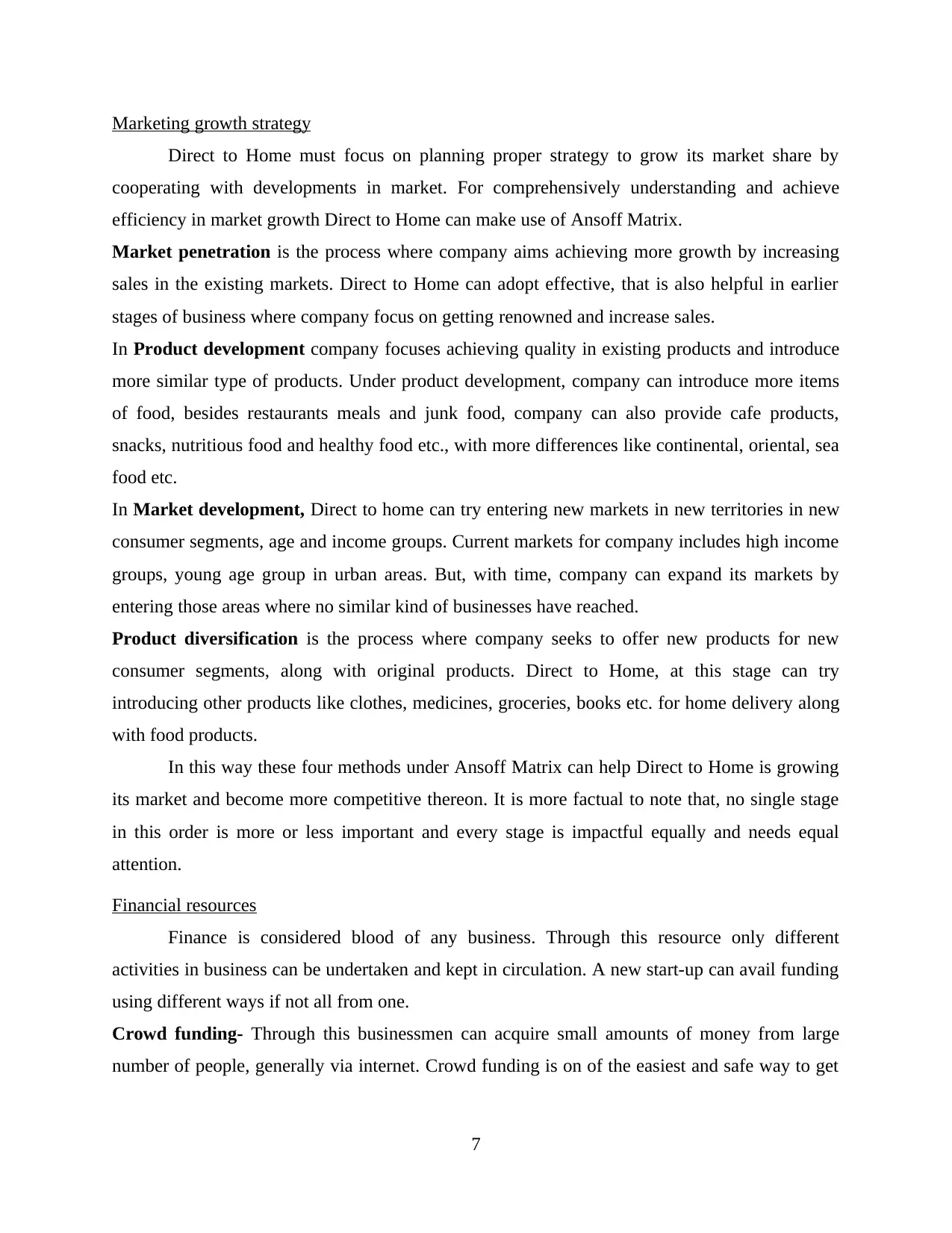
Marketing growth strategy
Direct to Home must focus on planning proper strategy to grow its market share by
cooperating with developments in market. For comprehensively understanding and achieve
efficiency in market growth Direct to Home can make use of Ansoff Matrix.
Market penetration is the process where company aims achieving more growth by increasing
sales in the existing markets. Direct to Home can adopt effective, that is also helpful in earlier
stages of business where company focus on getting renowned and increase sales.
In Product development company focuses achieving quality in existing products and introduce
more similar type of products. Under product development, company can introduce more items
of food, besides restaurants meals and junk food, company can also provide cafe products,
snacks, nutritious food and healthy food etc., with more differences like continental, oriental, sea
food etc.
In Market development, Direct to home can try entering new markets in new territories in new
consumer segments, age and income groups. Current markets for company includes high income
groups, young age group in urban areas. But, with time, company can expand its markets by
entering those areas where no similar kind of businesses have reached.
Product diversification is the process where company seeks to offer new products for new
consumer segments, along with original products. Direct to Home, at this stage can try
introducing other products like clothes, medicines, groceries, books etc. for home delivery along
with food products.
In this way these four methods under Ansoff Matrix can help Direct to Home is growing
its market and become more competitive thereon. It is more factual to note that, no single stage
in this order is more or less important and every stage is impactful equally and needs equal
attention.
Financial resources
Finance is considered blood of any business. Through this resource only different
activities in business can be undertaken and kept in circulation. A new start-up can avail funding
using different ways if not all from one.
Crowd funding- Through this businessmen can acquire small amounts of money from large
number of people, generally via internet. Crowd funding is on of the easiest and safe way to get
7
Direct to Home must focus on planning proper strategy to grow its market share by
cooperating with developments in market. For comprehensively understanding and achieve
efficiency in market growth Direct to Home can make use of Ansoff Matrix.
Market penetration is the process where company aims achieving more growth by increasing
sales in the existing markets. Direct to Home can adopt effective, that is also helpful in earlier
stages of business where company focus on getting renowned and increase sales.
In Product development company focuses achieving quality in existing products and introduce
more similar type of products. Under product development, company can introduce more items
of food, besides restaurants meals and junk food, company can also provide cafe products,
snacks, nutritious food and healthy food etc., with more differences like continental, oriental, sea
food etc.
In Market development, Direct to home can try entering new markets in new territories in new
consumer segments, age and income groups. Current markets for company includes high income
groups, young age group in urban areas. But, with time, company can expand its markets by
entering those areas where no similar kind of businesses have reached.
Product diversification is the process where company seeks to offer new products for new
consumer segments, along with original products. Direct to Home, at this stage can try
introducing other products like clothes, medicines, groceries, books etc. for home delivery along
with food products.
In this way these four methods under Ansoff Matrix can help Direct to Home is growing
its market and become more competitive thereon. It is more factual to note that, no single stage
in this order is more or less important and every stage is impactful equally and needs equal
attention.
Financial resources
Finance is considered blood of any business. Through this resource only different
activities in business can be undertaken and kept in circulation. A new start-up can avail funding
using different ways if not all from one.
Crowd funding- Through this businessmen can acquire small amounts of money from large
number of people, generally via internet. Crowd funding is on of the easiest and safe way to get
7
Paraphrase This Document
Need a fresh take? Get an instant paraphrase of this document with our AI Paraphraser
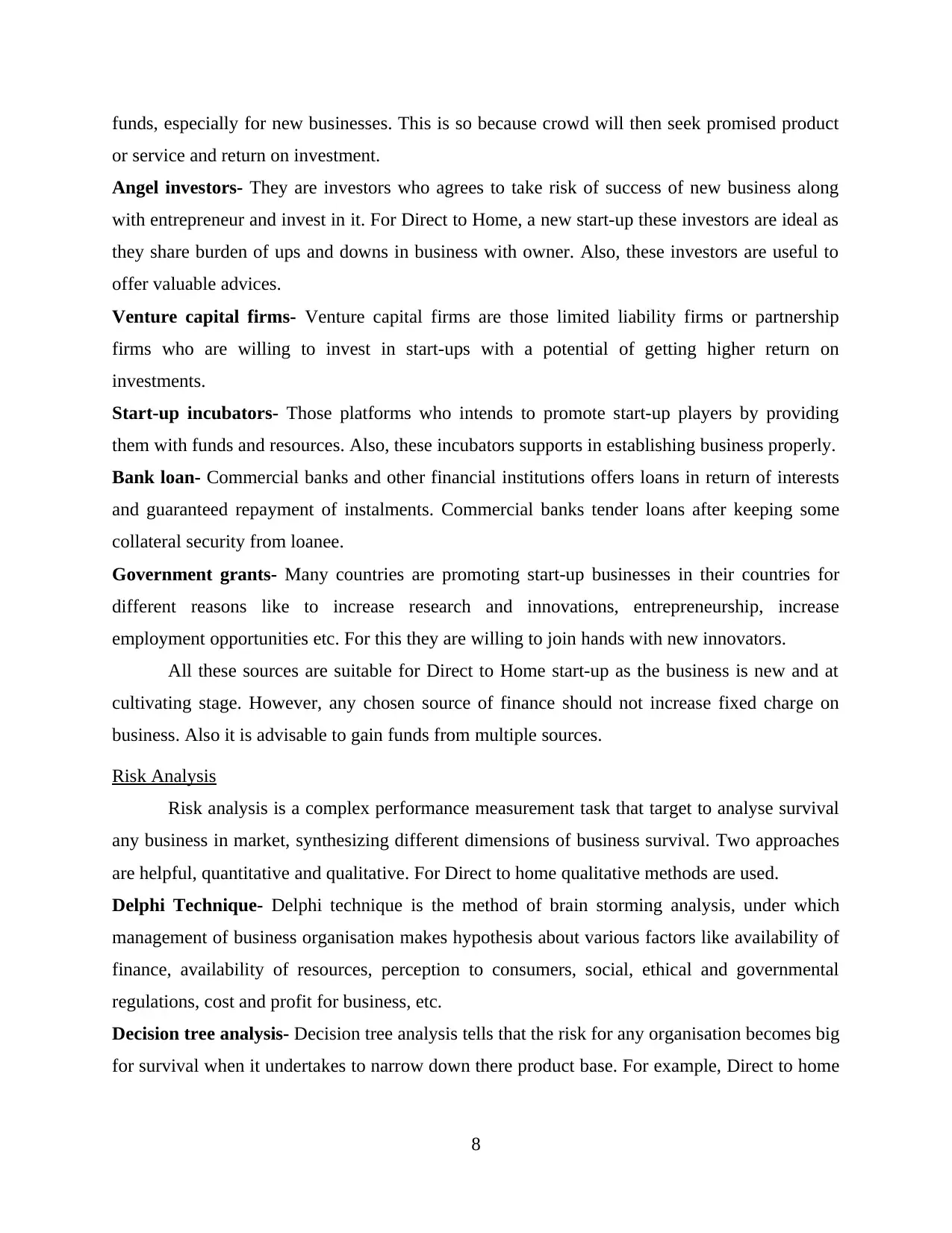
funds, especially for new businesses. This is so because crowd will then seek promised product
or service and return on investment.
Angel investors- They are investors who agrees to take risk of success of new business along
with entrepreneur and invest in it. For Direct to Home, a new start-up these investors are ideal as
they share burden of ups and downs in business with owner. Also, these investors are useful to
offer valuable advices.
Venture capital firms- Venture capital firms are those limited liability firms or partnership
firms who are willing to invest in start-ups with a potential of getting higher return on
investments.
Start-up incubators- Those platforms who intends to promote start-up players by providing
them with funds and resources. Also, these incubators supports in establishing business properly.
Bank loan- Commercial banks and other financial institutions offers loans in return of interests
and guaranteed repayment of instalments. Commercial banks tender loans after keeping some
collateral security from loanee.
Government grants- Many countries are promoting start-up businesses in their countries for
different reasons like to increase research and innovations, entrepreneurship, increase
employment opportunities etc. For this they are willing to join hands with new innovators.
All these sources are suitable for Direct to Home start-up as the business is new and at
cultivating stage. However, any chosen source of finance should not increase fixed charge on
business. Also it is advisable to gain funds from multiple sources.
Risk Analysis
Risk analysis is a complex performance measurement task that target to analyse survival
any business in market, synthesizing different dimensions of business survival. Two approaches
are helpful, quantitative and qualitative. For Direct to home qualitative methods are used.
Delphi Technique- Delphi technique is the method of brain storming analysis, under which
management of business organisation makes hypothesis about various factors like availability of
finance, availability of resources, perception to consumers, social, ethical and governmental
regulations, cost and profit for business, etc.
Decision tree analysis- Decision tree analysis tells that the risk for any organisation becomes big
for survival when it undertakes to narrow down there product base. For example, Direct to home
8
or service and return on investment.
Angel investors- They are investors who agrees to take risk of success of new business along
with entrepreneur and invest in it. For Direct to Home, a new start-up these investors are ideal as
they share burden of ups and downs in business with owner. Also, these investors are useful to
offer valuable advices.
Venture capital firms- Venture capital firms are those limited liability firms or partnership
firms who are willing to invest in start-ups with a potential of getting higher return on
investments.
Start-up incubators- Those platforms who intends to promote start-up players by providing
them with funds and resources. Also, these incubators supports in establishing business properly.
Bank loan- Commercial banks and other financial institutions offers loans in return of interests
and guaranteed repayment of instalments. Commercial banks tender loans after keeping some
collateral security from loanee.
Government grants- Many countries are promoting start-up businesses in their countries for
different reasons like to increase research and innovations, entrepreneurship, increase
employment opportunities etc. For this they are willing to join hands with new innovators.
All these sources are suitable for Direct to Home start-up as the business is new and at
cultivating stage. However, any chosen source of finance should not increase fixed charge on
business. Also it is advisable to gain funds from multiple sources.
Risk Analysis
Risk analysis is a complex performance measurement task that target to analyse survival
any business in market, synthesizing different dimensions of business survival. Two approaches
are helpful, quantitative and qualitative. For Direct to home qualitative methods are used.
Delphi Technique- Delphi technique is the method of brain storming analysis, under which
management of business organisation makes hypothesis about various factors like availability of
finance, availability of resources, perception to consumers, social, ethical and governmental
regulations, cost and profit for business, etc.
Decision tree analysis- Decision tree analysis tells that the risk for any organisation becomes big
for survival when it undertakes to narrow down there product base. For example, Direct to home
8
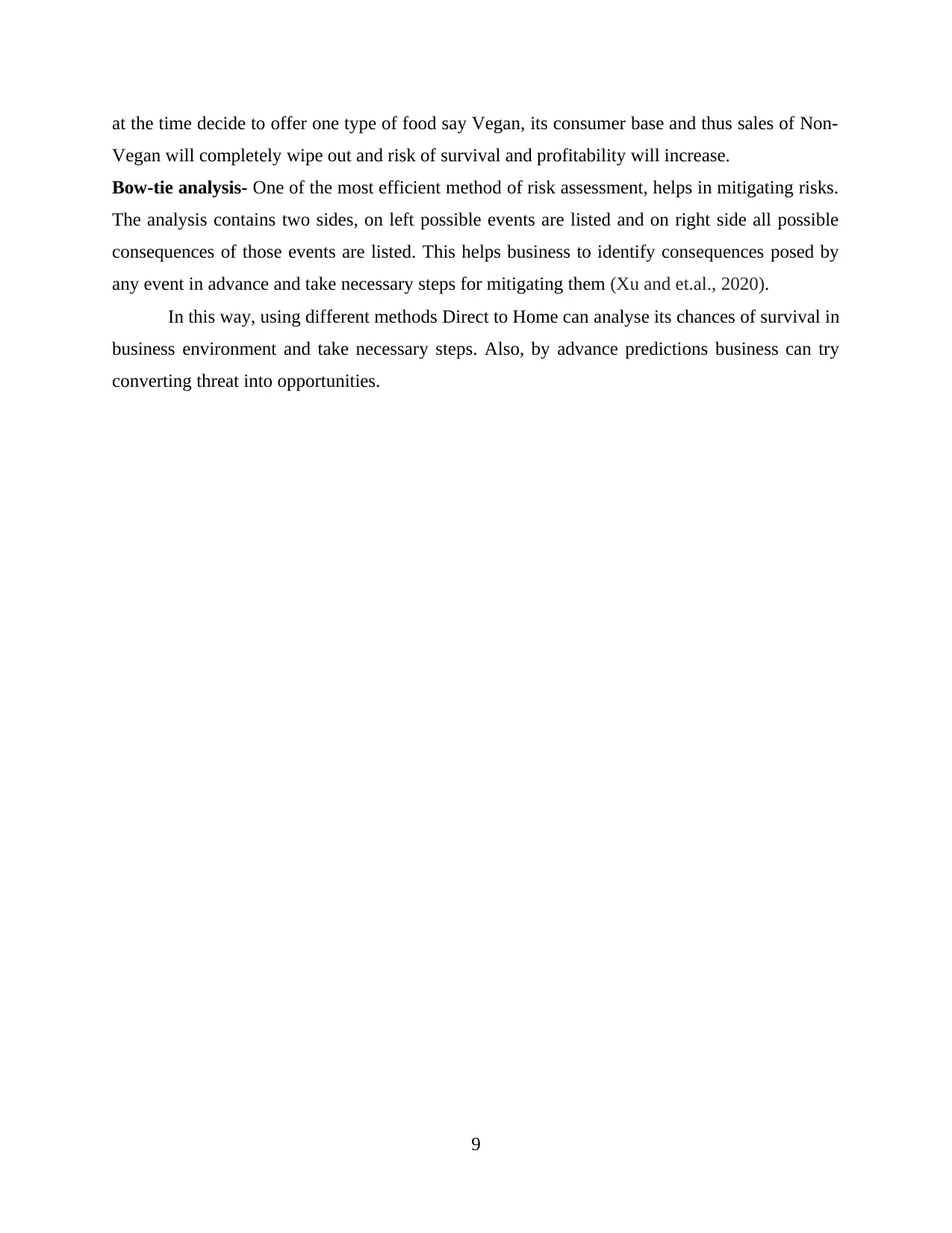
at the time decide to offer one type of food say Vegan, its consumer base and thus sales of Non-
Vegan will completely wipe out and risk of survival and profitability will increase.
Bow-tie analysis- One of the most efficient method of risk assessment, helps in mitigating risks.
The analysis contains two sides, on left possible events are listed and on right side all possible
consequences of those events are listed. This helps business to identify consequences posed by
any event in advance and take necessary steps for mitigating them (Xu and et.al., 2020).
In this way, using different methods Direct to Home can analyse its chances of survival in
business environment and take necessary steps. Also, by advance predictions business can try
converting threat into opportunities.
9
Vegan will completely wipe out and risk of survival and profitability will increase.
Bow-tie analysis- One of the most efficient method of risk assessment, helps in mitigating risks.
The analysis contains two sides, on left possible events are listed and on right side all possible
consequences of those events are listed. This helps business to identify consequences posed by
any event in advance and take necessary steps for mitigating them (Xu and et.al., 2020).
In this way, using different methods Direct to Home can analyse its chances of survival in
business environment and take necessary steps. Also, by advance predictions business can try
converting threat into opportunities.
9
⊘ This is a preview!⊘
Do you want full access?
Subscribe today to unlock all pages.

Trusted by 1+ million students worldwide
1 out of 14
Related Documents
Your All-in-One AI-Powered Toolkit for Academic Success.
+13062052269
info@desklib.com
Available 24*7 on WhatsApp / Email
![[object Object]](/_next/static/media/star-bottom.7253800d.svg)
Unlock your academic potential
Copyright © 2020–2025 A2Z Services. All Rights Reserved. Developed and managed by ZUCOL.




